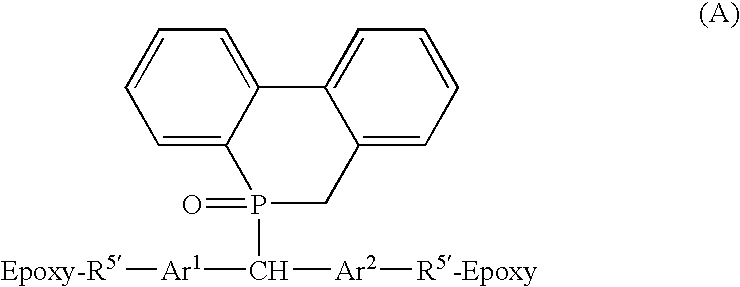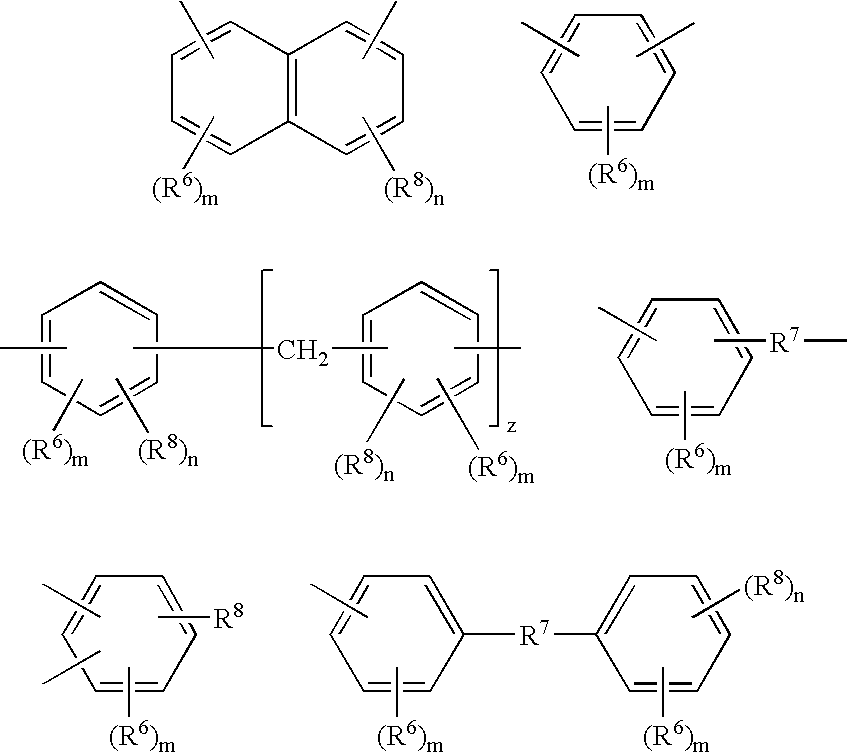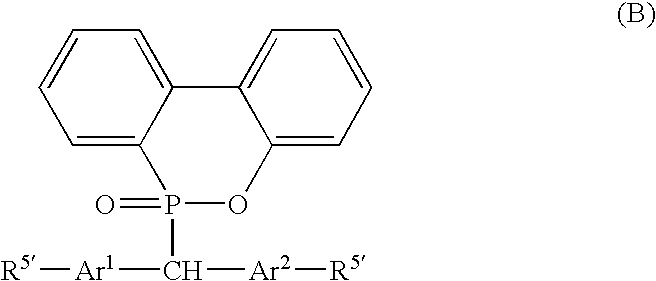Flame retardant resin and flame retardant composition containing the same
a technology of flame retardant resin and flame retardant composition, which is applied in the direction of plastic/resin/waxes insulators, basic electric elements, solid-state devices, etc., can solve the problems of adversely affecting human health, laminated plates may break or crack during manufacture, and other problems, to achieve the effect of improving electrical and mechanical properties, excellent heat resistance and flame retardant properties
- Summary
- Abstract
- Description
- Claims
- Application Information
AI Technical Summary
Benefits of technology
Problems solved by technology
Method used
Image
Examples
synthesis example 1
Synthesis of Phosphorus-Containing Compound HCP
[0117]216 g of organic cyclic phosphorus compound HCA (9,10-dihydro-9-oxa-10-phosphaphenanthrene-10-oxide) was placed in a glass reaction kettle and stirred to melt. When the temperature reached 110° C., 32.6 g of polyformaldehyde (produced by Chang Chun Plastics Co., Ltd. Taiwan, Paraformaldehyde 92%) was added, the temperature was elevated to 150° C., and the reaction was continued for more than 3 hours. After the pressure was decreased to 20 mmHg and kept for 1 hour, yielding 246 g of organic cyclic phosphorus compound HCAL, 246 g of toluene was added. The toluene was heated and stirred to dissolve in the glass reaction kettle. When the temperature reached 110° C., 94 g of phenol and 2.5 g of p-toluenesulfonic acid were added, and the reaction was continued for 3 hours. Then the reaction was cooled down to the room temperature, the reaction mixture was filtered and dried to give an organic cyclic phosphorus compound referred to as HC...
synthesis example 2
Synthesis of Phosphorus-Containing Compound HDP
[0120]Organic cyclic phosphorus compound HCA (216 g) placed in a glass reaction kettle was heated and stirred to melt. When the temperature reached 110° C., 72.5 g of 40% glyoxal was added, and the reaction was continued for more than 3 hours. Then the reaction was cooled down to the room temperature, the reaction mixture was filtered and dried to give an organic cyclic phosphorus compound referred to as HCAG.
[0121]The organic cyclic phosphorus compound HCAG formed in the above-mentioned reaction has a melting point of 243° C. The result of the elementary analysis is as follow:
[0122]
C%H%P%Found: 63.9% 4.1% 12.5%Calculated:63.67%4.08%12.65%(C26H20O6P2 formula weight = 490)
[0123]245 g of organic cyclic phosphorus compound HCAG and 245 g of toluene were placed in the glass reaction kettle, heated, and stirred to dissolve. When the temperature reached 110° C., 94 g of phenol and 2.5 g of p-toluenesulfonic acid were added, and the reaction w...
synthesis example 3
Synthesis of Organic Cyclic Phosphorus-Containing Compound HPP
[0126]Organic cyclic phosphorus compound HCA (216 g) placed in a glass reaction kettle was heated and stirred to melt. When the temperature reached 110° C., 112 g of 4-hydroxybenzaldehyde was added, and the reaction then continued for more than 3 hours. After the reaction was cooled down to the room temperature, the reaction mixture was filtered and dried to give an organic cyclic phosphorus compound referred to as HCAB. M.p.=212° C.
[0127]The organic cyclic phosphorus compound HCAB (338 g) and toluene (338 g) were placed into a glass reaction kettle and heated under stirring. When the temperature reached 110° C., 94 g of phenol and 3.4 g of p-toluenesulfonic acid were added, and the reaction was continued for further more than 3 hours. The reaction mixture was cooled down to room temperature, filtered and dried to give an organic compound referred to as HPP.
[0128]The organic cyclic phosphorus compound HPP formed in the ab...
PUM
| Property | Measurement | Unit |
|---|---|---|
| temperature | aaaaa | aaaaa |
| glass transition temperature | aaaaa | aaaaa |
| temperature | aaaaa | aaaaa |
Abstract
Description
Claims
Application Information
 Login to View More
Login to View More - R&D
- Intellectual Property
- Life Sciences
- Materials
- Tech Scout
- Unparalleled Data Quality
- Higher Quality Content
- 60% Fewer Hallucinations
Browse by: Latest US Patents, China's latest patents, Technical Efficacy Thesaurus, Application Domain, Technology Topic, Popular Technical Reports.
© 2025 PatSnap. All rights reserved.Legal|Privacy policy|Modern Slavery Act Transparency Statement|Sitemap|About US| Contact US: help@patsnap.com



